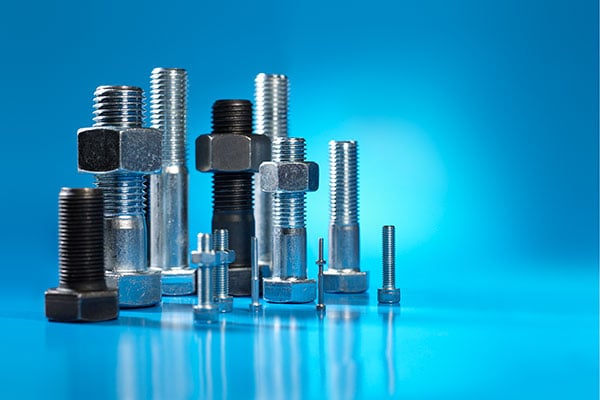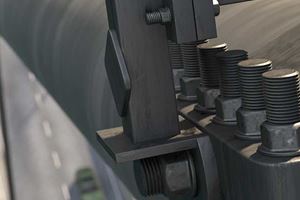10 tips for secure bolting
Achieving the safest, most secure bolted connection involves many factors. To help you achieve the best possible results, we have summarized into ten bolting tips. Please note that this is general advice and does not necessarily apply to all bolting situations.
1. Size and grade – “Choose the right combination of bolt size and grade”
In bolting, bigger does not necessarily mean better. Similarly, a higher grade bolt is not automatically an improvement to a lower grade bolt. What is important is the combination of these two factors.
“If everyone chose the right bolt size and the right material, then extra bolt-securing solutions wouldn’t be needed,” says Bill Eccles, the founder of boltscience.com
Eccles explains that the bolt size and the strength grade can positively or negatively affect the load in the bolt. Once you have the right combination, and you correctly tighten the joint, it is this load that is the crucial factor for your bolted joint to remain secure. “You could use a larger bolt with a lower strength grade, or a smaller bolt in a high strength grade,” he says. “Both could be suitable.” When considering these types of critical design options, the engineers at Nord-Lock Group can be a helpful resource.
2: Slackening – “Create elasticity in the joint to compensate for slackening”
Slackening is one of the main reasons bolts come loose. There are three main causes: settlement of rough or irregular surfaces; relaxation, when materials such as polymers or composites become more compact; creep, which is the tendency of materials to move or deform plastically under stress and elevated temperatures. All three cause loss of preload and can lead to bolted joint failures.
Slackening is a growing problem today as bolted joints are exposed to ever higher temperatures and loads, while components are increasingly made from composites, plastics, and aluminum.
The solution, says Robin Senn, Sales Engineer at Nord-Lock Group in Switzerland, is two-fold: “To compensate for slackening you need smooth and hard surfaces, and you need to introduce elasticity into the bolted connection, such as by using Nord-Lock X-series washers or Superbolt multi-jackbolt tensioners.”
Superbolt MJTs, as well as multifunctional wedge-locking technology from Nord-Lock, increase the elasticity of the joint to minimize slackening.
3: Lubrication – “Choose the right lubrication for your application”
It’s hard to overstate the importance of lubrication in regards to bolted joints. It minimizes friction scatter and reduces the torque-to-load ration. Lubrication also eases installation and removal and extends the life of the bolt.
Hidenori Araki, Field Application Engineer at Nord-Lock Group in the USA, recommends applying lubrication under the bolt head or nut and on the engaged threaded part of the bolt.
The most important thing to bear in mind when it comes to lubrication, he says, is to choose a suitable lubrication for your application. “Some of the parameters to take into consideration are chemical composition, health and environmental impact, service temperature ranges, and friction coefficient. Check the lubrication manufacturer for recommended usage.”
4: Design/maintenance – “Focus on the lifecycle costs”
During the design stage of a project, a frequent dilemma is whether to keep costs down in the present by using more economical solutions or make savings in the long term by investing in higher quality solutions.
Martin Lindbäck, Head of R&D Project Management Office at Siemens Industrial Turbomachinery, says: “Don’t only focus on the initial costs. Making the right investment early on will reap large cost savings later. This approach will also lead to more satisfied customers.”
Siemens took this long-term approach when it came to a bolt-securing solution for its multimillion Euro gas turbines, which led to an investment in Nord-Lock washers and Superbolt tensioners from Nord-Lock Group. This gave cost savings not only during assembly but resulted in huge savings on maintenance costs over the life cycle of the turbines.
5: Coatings – “Consider coatings to improve your bolted joint”
Coatings may be only a few micrometers thick, but they can improve a fastener’s performance in several ways: protecting against corrosion; reducing friction; enhancing the aesthetic value. There are a number of coating solutions available, the most cost-effective and simplest of which is galvanization. When this is not enough, zinc alloys can be used. If even greater protection is needed, multi-layered zinc flakes are recommended.
So which coating should you choose for your application? Some coating characteristics should weigh heavier than others. Choose your coating based firstly on the level of corrosion protection it offers; then on what friction characteristics you need as you can always compensate with a lubricant, and finally on aesthetic properties.
6: Genuine products – “Invest in the real thing – or you’ll pay later”
From sneakers to smartphones, cheap copies and counterfeit goods are rife everywhere. And bolting products are no exception.
The benefit of investing in genuine products, such as Nord-Lock washers, is that you get a product that has been on the market for a long time and has proven performance and quality.
Genuine Nord-Lock products can be identified by a laser marking. If you are unsure whether you have bought the real thing, contact your local registered sales office, where you can get help with verification.
“As with many things in life, with bolting solutions, you get what you pay for,” says Frida Cullin, Manager of Nord-Lock Technical Centres. “The purchase cost for a genuine product may be higher, but you save in the long term on reliability and reduced maintenance/repair costs.”
7: Quality – “Work with partners known for their expertise”
There are thousands of fastening solutions available. But even those widely used for certain applications may not be approved for a specific temperature or pressure range. So finding partners to help you achieve high material reliability and the right choice of fastening is crucial.
Peter Fjordman, of Bolt Securing, says: “The cost of a recall or the damage to a brand can be significant. When I read about an accident caused by a ventilation system leaking, for example, I wonder if it may have been because the company chose the wrong fastening solution.”
“Achieving high quality is about working with partners known for their expertise, who will prioritize quality over making a quick profit,” says Fjordman.
Nord-Lock Group is recognized for reliability and holds several quality certificates and accreditations for demanding applications, e.g. offshore, energy and transportation.
8: Corrosion – “Consider corrosion from the beginning in bolted joint design”
They say that the only certainties in life are death and taxes. But a third can be added: corrosion. Any metal product derived from iron or steel will eventually rust and disintegrate when it comes into contact with oxygen and water. “Corrosion will inevitably occur at a certain time,” says Christian Rabe at Dörken MKS-Systeme, which develops micro-layer corrosion protection systems. “Yet there are ways to arrest its progress.”
One method is cathodic protection – where a less noble material, such as zinc, sacrifices itself – and another method is non-cathodic protection. Rabe says there are no easy answers when it comes to corrosion. “The only solution would be to keep your endangered parts in a very dry desert climate,” he jokes.
Nord-Lock wedge-locking solutions offer a wide range of protective coatings and surface treatments as well as several grades of stainless steel and nickel-based alloys.
9: Reuse – “If you have to reuse, lubricate”
To reuse or not to reuse, that is often the question. Reusing fasteners – particularly in the field – is more convenient than carrying around replacements of various sizes and grades. Plus, it is cheaper.
However, it is hard to know if used fasteners are damaged, and might therefore fail. To check if a bolt you are planning to reuse is up to the task, Lena Kalmykova, Application Engineer at Nord-Lock Group, recommends a visual inspection. “If you see signs of corrosion, avoid reuse if possible. And the same goes for visible thread damage.”
“But there may be times when you have no alternative but to reuse a damaged bolt as a temporary solution. If you have to reuse, then lubricate,” says Kalmykova. “It provides a degree of protection against corrosion. And if you have a damaged thread, lubrication will help achieve the clamp load you require until you’re able to install a new bolt.”
10: Preload and tightening – “Choose the right tool and the right sequence”
The preload level determines the capacity of a bolted joint. Therefore it is crucial to determine the preload level required in a joint and then to achieve it through a suitable tightening method and a proper tightening sequence.
Preload must be sufficient to prevent movement between, or separation of, clamped parts, but still within the yield limit of the material to avoid embedment of mating surfaces and thread stripping.
Zouhair Chaib, Senior Technical Expert at Nord-Lock Group in France, says it is also important to differentiate between the static and dynamic capacity of a screw; a screw can withstand a high static load, but only a small amount of dynamic load. Therefore it is important to have a high preload to reduce the effect of dynamic working loads applied to the joint.
“When tightening, it is important that you choose a tool and a tightening sequence that enable you to achieve the preload that the design engineer has specified,” says Chaib.
Nord-Lock Group engineers are experts in providing complete solutions for bolted joints including design, product selection, and on-site support.
- Note that this is general advice and does not necessarily apply to all bolting situations.







